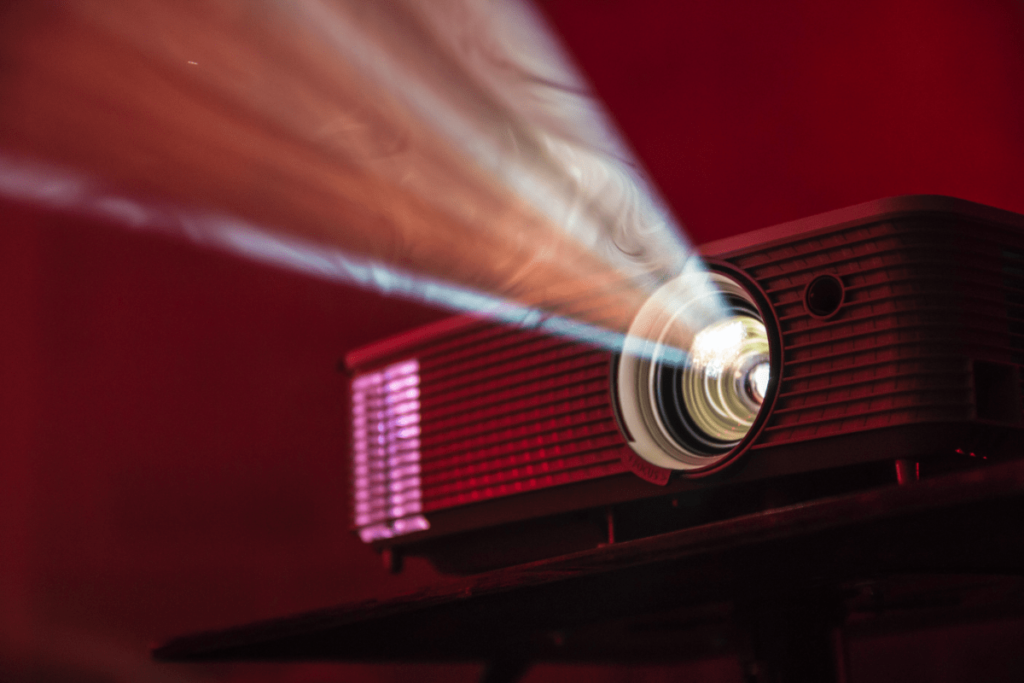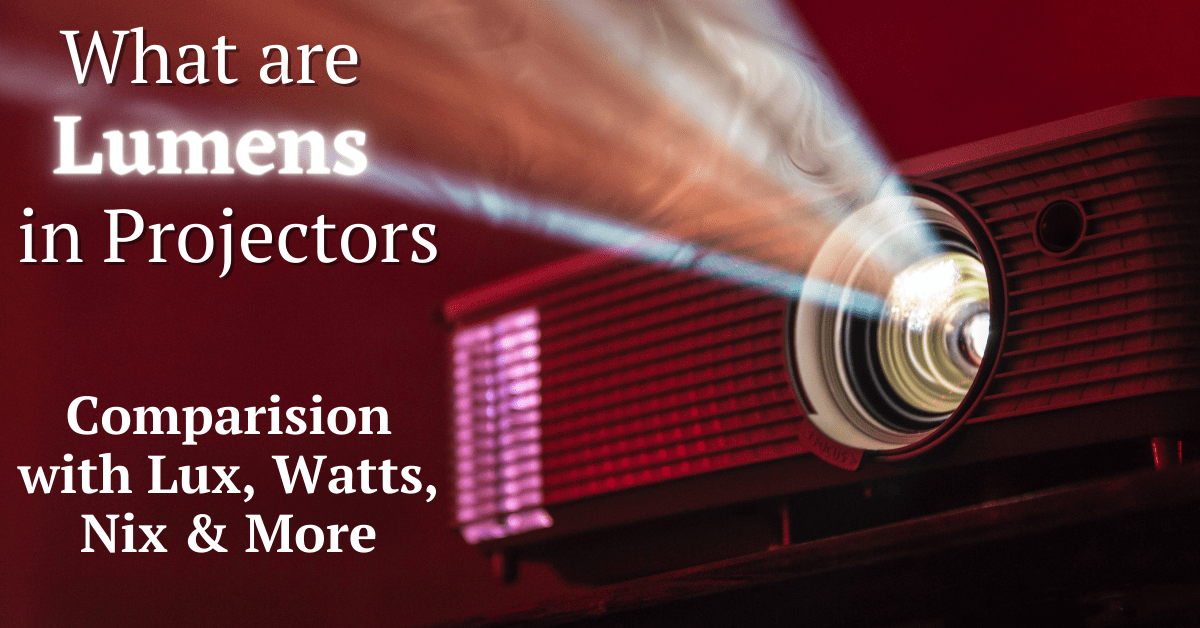Last Updated on July 8, 2024 by Admin
Lumens plays an essential role in the world of Projectors, as it determines the brightness and clarity of the projected image. So, whether you are conducting a presentation, setting up a home theater, or enhancing an outdoor event, understanding lumens is very important.
This guide will help you understand what are lumens, how they differ from Lux, Watts, Nit, and other Brightness Measures, their importance in projectors, how lumens are measured and calculated, practical tips for choosing the right lumens, and common misconceptions.
Additionally, we will also answer the most frequently asked questions like How Many Lumens is Good for a Projector, Can You Increase Lumens in a Projector, How Many Lumens Do I Need, How do lumens affect projector screen size, and more.
You might also be interested in learning more about What is Projector and How do Projectors Work.
Page Contents
What are Lumens?
Understanding what are lumens is crucial when choosing the right projector for your home theater.
Basically, Lumens is the unit of measuring the brightness of the light source. Whether it’s a candle, a fluorescent lamp in your room, sunlight, or the light projected from a projector, each light source emits varying levels of brightness.
Instead of describing brightness subjectively—like saying a candle is dim or a bulb is bright—we use a device to measure the actual brightness in lumens.
For example, a candle emits about 14 lumens, a 100-watt bulb produces around 1600 lumens, and on a sunny day, the sun can produce approximately 100,000 lumens.
So, we use lumens to measure the brightness of projectors, ensuring a standardized understanding of their light output.
Now that you know What are Lumens, we will discuss how they differ from Lux, Watts, and Other Brightness Measures.
Lumens Definition:
Lumens are a unit of measurement that indicates the total amount of visible light emitted by a source per second. It is often denoted by lm.
What is Projector Lumens?
Understanding what are lumens is crucial when choosing the right projector for your needs. Lumens serve as a universal measure of brightness for any light-emitting device. When discussing the measurement of brightness from a projector’s light source, it is referred to as projector lumens.
The brightness level emitted by a projector is measured in lumens. Generally, a higher lumen count results in a brighter and clearer picture. You need to decide the appropriate use for a projector based on its lumen rating.
Basically, Projectors on the market typically range from 500 to 20,000 lumens. For instance, a projector emitting 1000 lumens is suitable for a dark room. Conversely, for a room with windows and some ambient light, a projector with a higher lumen count is necessary. We will discuss in detail how many lumens are ideal for various projector uses later in this article.

Importance of Lumens:
Practical Applications of Lumens:
- Consumer Decision-Making: Understanding Lumens can help consumers choose the right lighting product based on its brightness. For instance, a 60-watt incandescent bulb emits around 800 lumens. So, the consumer can replace it with a cost-efficient LED bulb that provides similar lumens but uses very little energy.
- Energy Efficiency: Focusing on lumens allows consumers to have better energy management. More lumens per watt (lm/W) indicate a more efficient light source, helping to reduce energy bills and environmental impact.
- Application Versatility: Lumens are used in various applications, from residential lighting to commercial and industrial settings. Knowing the lumen output helps in selecting the right light for different needs, such as ambient lighting, task lighting, or accent lighting.
- Home Lighting: When selecting bulbs for home use, checking the lumens helps in achieving the desired brightness for different rooms. For instance, living rooms might require 1,500 to 3,000 lumens, while bedrooms may need 1,000 to 2,000 lumens.
- Outdoor Lighting: Lumens can help determine the brightness needed for outdoor spaces for safety and security. For instance, Pathway lights may need 100 to 200 lumens, while floodlights for security can range from 700 to 1,300 lumens.
- Commercial and Industrial Lighting: In commercial and industrial settings, understanding lumens ensures adequate lighting for workspaces, enhancing productivity and safety. Warehouses, for instance, may require 300 lumens per square meter for optimal visibility.
Practical Applications of Projectors Lumens:
- Consumer Decision-Making: When discussing projectors, understanding what are lumens becomes pivotal in selecting the right model for your needs. Understanding lumens helps consumers choose the right projector based on brightness needs. For example, a projector with 2,000 lumens may be suitable for a dimly lit home theater, while a brighter projector with 3,500 lumens might be necessary for a well-lit conference room.
- Energy Efficiency: Focusing on Projectors Lumens allows for efficient energy management. DLP Projectors emit high lumens but also consume more electricity. On the other hand, LED Projectors with higher lumens per watt (lm/W) provide brighter images while using less electricity, reducing operating costs and environmental impact.
- Application Versatility: Lumens play a crucial role in projector selection for various applications. Whether for home entertainment, outdoor settings, or professional presentations, knowing the projector’s lumen output helps match it to the specific lighting conditions and viewing needs.
- Optimal Home Theater Setup: Selecting a projector based on lumens ensures optimal brightness levels for home theater setups. Higher lumens (e.g., 2,000 to 3,000 lumens) are typically preferred for vivid image quality in darkened environments, enhancing the viewing experience.
- Outdoor Projection: Lumens determine the suitability of projectors for outdoor use, such as in outdoor events or movie screenings. Projectors with sufficient lumens (e.g., 3,500 lumens or more) are essential for clear visibility despite ambient light conditions.
- Business and Educational Settings: In environments like classrooms or conference rooms, choosing projectors with adequate lumens ensures clear visibility of content even in well-lit areas. Higher-lumen projectors (e.g., 3,000 lumens and above) are beneficial for maintaining image clarity and visibility during presentations.

Comparing Lumens to Other Units
Watts Vs Lumens:
The concept of lumens has been around for a long time, but they became more prominent with energy-efficient lighting (CFLs, LEDs, etc). Older bulbs were mostly rated by watts, and people thought watts measured brightness. However, watts are actually used to measure energy consumption, not brightness.
But, since the rise of LED and other energy-efficient lighting technologies, lumens have become the standard unit for measuring brightness or light output. This change allows consumers to compare lighting products based on their brightness, not based on energy usage.
Lux Vs Lumens:
Lumens and lux are both measurements related to light, but they serve different purposes. Lumens measure the total amount of visible light emitted by a source, regardless of where the light is directed. On the other hand, lux measures the amount of light that actually reaches a surface or an area. It tells us how bright the light appears at a specific point or location
For instance, Lumens are like measuring how much water flows out of a hose. Whereas, Lux measures how much water falls on the surface.
Technically, Lumens describes the brightness of a Light Source, such as a Projector Bulb. However, Lux helps us determine how bright the surface will be when the light falls from that light source. This distinction is important in applications where light intensity at a particular spot matters, such as in photography, outdoor lighting design, or workspace illumination.
Lumens vs. Nits:
Lumens and nits both measure brightness, but they do so in different contexts. Nits measure brightness per unit area.
As we took the example of Lumens as measuring the water flowing out of a hose, Nits is like feeling the force of water spray at a specific distance. Nits are commonly used for displays, like TVs and monitors, to ensure they are bright enough for viewing even in well-lit rooms.
Lumens vs. Foot-Candles:
Foot-candles measure how much light actually falls on a surface. It’s like measuring how much rain falls on the ground versus how much water is in the entire cloud. Foot-candles are often used in lighting design to ensure spaces have enough light for specific tasks or safety requirements, such as in offices or outdoor areas.
Lumens vs. Candela:
As we have already mentioned, Lumens measure the total amount of light emitted by a source in all directions, like the total amount of water flowing from a fountain.
However, Candela measures the intensity of light in a specific direction, like how strong the water stream is in one particular spot.
Candela is used to describe the brightness of directional light sources, such as flashlights or car headlights.
Lumens vs. ANSI Lumens:
ANSI measures the average brightness in multiple spots on a screen. We did a comprehensive differentiation between Lumens Vs ANSI Lumens in another article.
Comparison Table: Lumens vs. Other Brightness Measures
| Measure | Lumens | Lux | Watts | Nits | Foot-Candles | ANSI Lumens |
| Definition | Total visible light output | Light intensity on a surface | Power consumption | Brightness per unit area | Light intensity on a surface | Standardized projector brightness |
| Unit | Lumens (lm) | Lux (lx) | Watts (W) | Candelas per square meter (cd/m²) | Foot-Candles (fc) | Lumens (ANSI) |
| Formula | – | Lumens / Area (m²) | – | Lumens / Area (m²) | Lumens / Area (ft²) | – |
| Used For | Projectors, light bulbs | Lighting design, illumination | Electrical power of light sources | Display screens (monitors, TVs) | Photography, stage lighting | Projectors |
| Key Points | Higher lumens = brighter light | Lux depends on distance and area | Does not indicate brightness directly | Higher nits = brighter display | Similar to lux but uses feet | Consistent way to compare projectors |
| Example | 1000 lumens projector | 500 lux in a room | 60W incandescent bulb | 300 nits display | 50 foot-candles on a stage | 1500 ANSI lumens projector |
Lumens in Projector:
Difference between White Lumens and Color Lumens
Some projector manufacturers may try to mislead consumers by highlighting only the white lumens in their promotions. To avoid being misled, it’s important to understand the difference between white lumens and color lumens, and why it matters.
White lumens measure the brightness of a projector when displaying white or grayscale images, which are typically brighter than when displaying colored images.
Color lumens, on the other hand, represent the brightness when displaying colored images. This distinction is crucial because some projectors may advertise high total lumens but have lower color lumens, affecting the vibrancy and accuracy of color reproduction.
When choosing a projector, consider checking both white and color lumens to ensure balanced brightness and vivid color performance across all types of content.

How Many Lumens is Good for a Projector
Learning what is lumens enables consumers to make informed decisions when investing in projector technology. There isn’t a single factor that determines how many lumens are ideal for a projector. The ideal number of lumens for a projector depends on several factors, including the intended use and ambient lighting conditions of the environment.
For a home theater or a darkened room, projectors with 1,000-2,000 lumens can provide sufficient brightness. In environments with ambient light or light interference, such as conference rooms, up to 2,500 lumens may be necessary. For outdoor settings, you may require even higher lumens to maintain clear visibility of images and text on the screen.
Check out Best Projectors for Outdoor Use. And How to Setup Projectors Outside.
Can You Increase Lumens in a Projector
Yes, changing the light source (bulb) in a projector can potentially increase the lumens if the new bulb is more powerful and compatible with the projector.
However, it’s essential to ensure that the projector can handle the higher power requirements and heat output of a more powerful bulb.
Upgrading to a higher-lumen bulb can lead to brighter images, but it must be done with consideration of the projector’s design and cooling capabilities to avoid damaging the device.
Besides that, you can optimize brightness settings and projector placement to enhance perceived brightness.
How Many Lumens Do I Need
When discussing projectors, knowing what are lumens guides decisions on which model suits different viewing environments. We cannot determine the exact number of Lumens you need as it depends on various factors. The surface on which you are projecting, the color of the Projector screen, ambient light, and environment are a few factors you need to consider to tell How many lumens you need.
Here is a comprehensive article on How Many Lumens you Need and what factors to see.
However, here is a rough estimation of How Many Lumens you might need.
- Home Theater: 1000-2000 lumens for dark rooms.
- Conference Rooms: 2500 lumens or higher for well-lit environments.
- Outdoor Use: 3000 lumens or more to combat sunlight and ambient light.
How Do Lumens Work
Lumens quantify the brightness of a projector by measuring the total amount of visible light emitted per second. The higher the lumens rating, the brighter the projected image appears.
Common Myths and Misconceptions
Myth: Higher Lumens Always Mean Better Quality
One might assume that higher lumens equate to better quality, but this isn’t always the case. Quality also depends on factors, such as resolution, contrast ratio, color accuracy, and more.
In fact, in some instances, high lumens in a small, dark room can actually be a disadvantage, leading to washed-out images and diminished output quality.
Myth: Lumens Determine Image Resolution
Another common myth is that lumens determine image resolution. However, this is not true. Lumens primarily influence brightness, not image resolution. Resolution refers to the number of pixels in an image, while lumens indicate the brightness level.
For a detailed explanation of different types of screen resolutions, you can refer to this excellent guide provided on this website.

How to Calculate Lumens
Method 1: (Using Watts and Efficacy)
Lumens = Watts×Efficacy
For example, a 60-watt incandescent bulb with an efficacy of 15 lm/W:
Lumens = 60W×15 lm/W = 900 lumens
Similarly, for a 10-watt LED with an efficacy of 90 lm/W:
Lumens = 10W×90 lm/W = 900 lumens
Method 2: (Using Lux and Screen Area)
Lumens = Average Lux×Screen Area
How to Measure Lumens
Lumens are measured using specialized equipment like Light Meter, Integrating Sphere, and ANSI Method.
For detailed information, you can read our article on How Lumens Are Measured
FAQs about Projector Lumens:
1. How do lumens affect projector screen size?
Higher lumens ensure that brightness is evenly distributed across larger screens. Conversely, on smaller screens, the image may appear brighter and whiter than anticipated due to the concentrated light output.
2. Can lumens be adjusted on projectors?
Yes, many projectors offer adjustable brightness features or eco-friendly modes that allow users to customize lumens output based on specific viewing environments and preferences.
3. What is the optimal lumen range for home theaters?
It depends on the room size, projector distance from the screen, and ambient light, among other factors. However, a Projector with moderate lumens like 1000-2000 lumens offers a satisfactory viewing experience in the living room and bedroom.
4. What are lumens in projectors?
In projector specifications, understanding what is lumens clarifies their role in determining viewing quality. In short, Lumens measures the brightness of a projector. The higher the lumens, the brighter the projected image will be.
5. How many lumens do I need for a home theater projector?
For a home theater projector, 1,500 to 2,500 lumens is usually sufficient for a dark room. If there is ambient light, consider a projector with higher lumens.
6. Is higher lumens always better for a projector?
Not necessarily. While higher lumens mean a brighter image, it’s important to balance brightness with other factors like resolution, contrast ratio, and the intended viewing environment.
7. What is the difference between lumens and lux?
Lumens measure the total light output from a projector, while lux measures the light intensity on a specific surface area.
8. How many lumens do I need for an outdoor projector?
For outdoor projectors, you generally need a Projector with more than 4,000 lumens to ensure a bright and clear image.
9. Can I use a low-lumen projector in a bright room?
Low-lumen projectors are not ideal for bright rooms as the image may appear washed out.
10. What is the ideal lumens for a classroom projector?
A classroom projector should have at least 2,500 to 3,500 lumens to ensure clear visibility, assuming that you can control ambient lighting.
11. Are lumens the only factor to consider when buying a projector?
No, there are other important factors you need to consider like resolution, contrast ratio, throw distance, and connectivity options. Lumens determine brightness, but overall projector performance depends on multiple features.
12. What is the difference between LED lumens and regular lumens?
LED lumens refer specifically to the brightness of LED light sources, while regular lumens can refer to any light source.
13. Can a projector be too bright for a dark room?
Yes, if a projector is too bright for a dark room, the image can cause eye strain. In such cases, choosing a projector with adjustable brightness settings or lower lumens is better.
14. Do lumens decrease over time in projectors?
Projector bulbs (Light Source) may fade over time, which will result in decreased brightness. So, Yes, Lumens decrease over time in Projectors.
15. Is there a standard for measuring lumens in projectors?
Yes, there are standardized methods for measuring lumens, such as Light Meter, Integrating Sphere, and ANSI Method.
Conclusion:
When planning to buy a Projector, it’s important to understand what are lumens to ensure optimal viewing experiences.
Projector Lumens is a measuring unit that measures the brightness of the Light Source in a Projector. Earlier, people used to purchase Lighting Products by looking at their Watts, thinking that Watts determined the brightness of the light. However, it became clear after lighting technology evolved and introduced energy-efficient lighting like CFLs, LEDs, etc. Watts are used to measure energy consumption, not Brightness. These energy-efficient lighting products emit the same amount of Lumens but consume much less energy. Therefore, modern light sources are measured using Lumens.
Understanding what lumens are and their impact on projector performance is essential for making informed decisions when purchasing or setting up projectors for various applications. Whether for presentations, home theaters, or outdoor events, understanding lumens is essential.
Hence, by understanding Lumens, consumers can make informed decisions based on their requirements. As lighting technology continues to evolve, the importance of lumens in guiding choices will only grow, promoting better energy use and enhanced lighting experiences.
In summary, lumens serve as a fundamental metric for evaluating projector brightness, ensuring optimal image clarity across diverse settings. Whether you’re a home theater enthusiast or a professional presenter, incorporating this knowledge into your projector selection process can significantly elevate your visual experiences.

